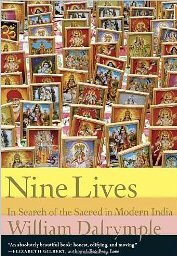Maybe…it is only those of us who have no eyes that can see through the lure of maya, and glimpse reality for what it is.
– Kanai, the blind minstrel in Nine Lives, p.246
A few days back, we got William Dalrymple’s well received book Nine Lives: In Search of the Sacred in Modern India from our local library.
The book is a collection of nine essays, each covering one life, i.e. the story of one individual.
Each essay addresses a different subject but two common threads run through the Nine Lives:
* The setting of the subject matter – they’re all located in the small towns and villages or what Dalrymple describes as “the places suspended between modernity and tradition.”
* All the essays look at the impact of the frenetic pace of development and change currently underway in India on the different religious traditions.
In Dalrymple’s own words:
Each life is intended to act as a keyhole into the way that each specific religious vocation has been caught and transformed in the vortex of India’s metamorphosis during this rapid period of transition, while revealing the extraordinary persistence of faith and ritual in a fast-changing landscape.

It’s a strange universe some of the ‘Lives” inhabit, practicing what may seem to the average eye to be bizarre customs and rituals.
If bizarre and odd are what turn you on, read the story of Manisha Ma Bhairavi in the The lady Twilight and follow it up with The Song of the Blind Ministrel. Tantric sadhanas, cremation ground rituals, drinking from human skulls, animal sacrifices, unusual sexual practices et al should certainly give you a high.
If that strikes you as weird, the Jain nun’s defense of sallekhana or slow starvation to death is equally odd:
No, no; sallekhana is not suicide…It is quite different. Suicide is a great sin, the result of despair. But sallekhana is as a triumph over death, an expression of hope.
Dalrymple promises not to judge this strange cast of characters characters and true to his word he does not.
Some of the essays, particularly Nun’s Tale, Daughters of Yellamma and Monk’s Tale are heartrending and make for poignant reading.
As you pore over the essays, you grasp that there’s a lot more to India than many of us city-slickers realize. An India outside the everyday purview of the software programmers, engineers, bureaucrats or even bloggers.
William Dalrymple deftly interweaves each of the lives with historical and other information related to the lives and their religious traditions.
For instance, we get a short account of Jainism in the story of Prasannamati Mataji. While not exhaustive, they are adequate and serve as an aperitif whetting the appetite for a deeper study of the country or subject.
From the essays, it’s obvious that Dalrymple has done extensive research and dipped his beak deep into the core of the subjects he handles with great panache. In different essays, he cites Huien Tsang, Dara Shukoh, the Vedas, and a variety of other rich sources.
Four stories are set in South India (Belgaum, Kannur, Swamimalai and Shravanabelagola), two in West Bengal, one in the rural Sindh region of Pakistan, one in Rajasthan and one in the mountainous terrain of Dharamsala.
Even for readers like yours truly hailing originally from India, the 251-page book is a cornucopia of interesting information.
There is an adequate glossary of Indian terms at the end to aid those not belonging to the sub-continent. Also included is a decent bibliography for each essay for the overzealous reader.
We can’t help wondering how Dalrymple decided on these Nine Lives.
How many ‘lives’ did he consider and discard before settling on these nine?
Also, it’d have been nice to see some pictures accompanying the narratives of these colorful characters.
SearchIndia.com strongly recommends Nine Lives.
In fact, we like the book so much that we’re considering buying a copy if we can find a cheap one on eBay or Half.com.


You must be logged in to post a comment Login